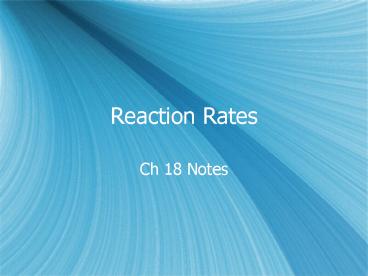Reaction Rates - PowerPoint PPT Presentation
1 / 18
Title:
Reaction Rates
Description:
Reaction Rates Ch 18 Notes Collision Theory Reacting substances (atoms, ions, molecules, etc.) must collide in order to react Collisions have to happen with the ... – PowerPoint PPT presentation
Number of Views:204
Avg rating:3.0/5.0
Title: Reaction Rates
1
Reaction Rates
- Ch 18 Notes
2
Collision Theory
- Reacting substances (atoms, ions, molecules,
etc.) must collide in order to react - Collisions have to happen with the correct
orientation - Reacting substances must have enough energy to
form the activation complex - this amount of energy is the activation
energy
3
sToP tHinK
- Space shuttles use liquid H2 and O2 in a chemical
reaction to get enough energy for propulsion. - Why do they use these substances in liquid phase
and not gaseous phase?
4
1. Reacting substances (atoms, ions, molecules,
etc.) must collide in order to react
5
2. Collisions have to happen with the correct
orientation
6
3. Reacting substances must have enough energy
to form the activation complex
7
Collision Theory - Pictoral Summary
8
Activation Energy
difference between starting energy and activated
complex.
9
(No Transcript)
10
Reactions happen in steps
- Most reactions are complex, meaning they happen
in two or more elementary steps - example
11
Different Energy diagrams
lt- single step
complex reaction -gt
12
sToP tHinK
- Assume that this reaction is reversible, meaning
that products can react to reform reactants.
Which direction of the reactants would have a
larger activation energy? - reactants to products OR products to reactants
13
Factors that affect Reaction Rate
- Nature of Reactants
- Concentration
- Surface Area
- Temperature
- Catalysis
14
1. Nature of Reactants
- Some elements/substances are more reactive than
others - Ionization energy
- Electronegativity
- Solid, Liquid, or Gas
- Single, Double, or Triple Bonds
15
2. Concentration
- Higher reactant concentrations means
- more particle collisions and, therefore, a faster
reaction rate because more collisions increases
the chance of having collisions with enough
energy and correct orientation.
16
3. Surface Area
- Greater surface area creates a larger interface
for particle collisions, so increases reaction
rate.
17
4. Temperature
- Higher temperature means higher kinetic energy,
more particle collisions, and faster reaction
rate.
18
5. Catalysts
- Very different from the other factors that affect
reaction rate - Instead of increasing/decreasing collisions,
catalysts lower the activation energy needed for
the reaction to occur - activation energy - amount of energy needed for a
reaction to take place - inhibitor - slows down or even blocks a reaction































